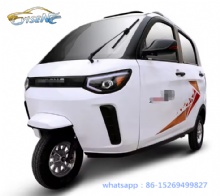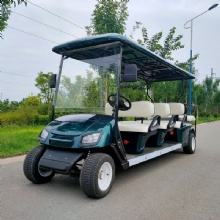Author:DavisDate:2025-10-30

With the increasing popularity of golf and the upgrading of course facilities, golf carts, as an important means of transportation on the course, are receiving more and more attention for their performance and adaptability to the terrain. As the core power components of a golf cart, the ability of the motor and electronic control system to be accurately matched to the course terrain directly affects the vehicle's range, driving stability, and operating costs. Recently, industry experts provided professional advice on matching motors and electronic control systems for golf carts under different terrain conditions.
Flat Courses: Focus on High Efficiency and Energy Saving, Prefer Low-Power Motors and Precise Electronic Controls
For golf courses with predominantly flat terrain and no significant slopes, the core of matching motors and electronic control systems lies in "high efficiency and energy saving." Industry engineer Mr. Li explained: "These types of courses do not require the motor to provide excessive torque. It is recommended to choose a 3-5kW permanent magnet synchronous motor, which has the advantages of low energy consumption and smooth operation, and can meet the vehicle's normal driving speed requirement of 20-25km/h on flat surfaces."

Regarding the electronic control system, the speed regulation accuracy and energy recovery function should be given special attention. “On flat courses, vehicles frequently start and stop, requiring the electronic control system to achieve precise speed adjustments at the 0.5km/h level to avoid starting shocks. Simultaneously, it should be equipped with a regenerative braking module to convert the kinetic energy from coasting or braking into electrical energy, extending the driving range by 15%-20%,” added Ms. Zhang, technical director of an electronic control equipment company. She added that current mainstream electronic control systems for flat courses also integrate battery management functions to monitor battery status in real time and ensure stable power supply.
Hilly Course: Enhanced torque output, matched with a medium-power motor and ramp electronic control.
When the course has gentle slopes of 5°-15° and significant terrain undulations, the torque performance of the motor and the slope adaptability of the electronic control system become crucial. “On hilly terrain, vehicles frequently go up and down slopes, requiring the motor to have sufficient instantaneous torque to handle slope starts. It is recommended to use a 5-8kW series-wound DC motor or a permanent magnet synchronous motor, whose peak torque can reach 150-200N・m, easily overcoming slopes up to 15°,” explained Mr. Wang, a golf cart manufacturer. The electronic control system must be equipped with "hill assist" and "overload protection" functions. "When the vehicle is going uphill, the electronic control system needs to automatically increase the motor's output power to prevent insufficient power from causing it to roll backward; when going downhill, it needs to activate brake current limiting protection to prevent the motor speed from being too high and damaging components," Ms. Zhang explained. She cited an example of a hilly golf course that previously used a standard electronic control system, which caused the golf cart to experience frequent motor overheating issues when going downhill. After replacing it with an electronic control system that features hill-adaptive adjustment, the failure rate decreased by 80%.

Mountain Golf Courses: Focusing on Power and Protection, Selecting High-Power Motors and Durable Electronic Control Systems
For mountain golf courses with slopes exceeding 15° and featuring gravel roads or bumpy surfaces, the "power strength" and "environmental adaptability" of the motor and electronic control system become the primary considerations. "Mountainous terrain places extremely high demands on motor power, requiring the selection of high-power DC separately excited motors of 8-12kW, with a continuous torque of 250-300N·m to meet the vehicle's stable driving needs on a 20° slope. Simultaneously, the motor must adopt an IP67 protection design to prevent mud, sand, and rainwater from entering internal components," emphasized Engineer Li. Regarding the electronic control system, in addition to strengthening power control, it is also necessary to improve anti-interference and durability. "Signal on mountain golf courses is easily blocked by the terrain, so the electronic control system needs to use communication modules resistant to electromagnetic interference to ensure stable signal transmission with the motor; furthermore, the heat dissipation performance of the electronic control unit is crucial. It is recommended to use an aluminum casing with a fan cooling design, which can operate normally in ambient temperatures ranging from -20℃ to 60℃," said Manager Zhao, the operations manager of a mountain golf course. He added that after his course replaced the motors with high-power ones and a dedicated electronic control system, the frequency of golf cart maintenance decreased from 3-4 times per month to once per quarter, significantly improving operational efficiency.

Experts Call for Terrain Adaptation Standards to Promote Industry Standardization
Faced with the need for adaptability to different terrains, industry experts are calling for the establishment of terrain adaptation standards for golf cart motors and electronic controls. "Currently, some courses exhibit a 'one-size-fits-all' purchasing phenomenon, blindly selecting high-power components leading to energy waste, or using low-power components causing malfunctions," said Mr. Chen, a member of the Facilities Committee of the China Golf Association. He suggested that in the future, a graded adaptation guide for motor power and electronic control functions could be developed based on parameters such as course slope and surface conditions. Simultaneously, companies should be encouraged to develop "terrain-adaptive" electronic control systems that use sensors to monitor the terrain in real time and automatically adjust motor output parameters, further improving the terrain adaptability of golf carts.
Industry insiders stated that with the differentiated development of golf courses, terrain adaptability of motors and electronic controls will become a core indicator for golf cart selection. The advancement of related technology research and development and the formulation of standards will provide strong support for the intelligent development of golf.
↓Next [ The annual Canton Fair is grandly held. Our companys booth is in the Golf Cart Outdoor Pavilion. We look forward to your visit. ]









